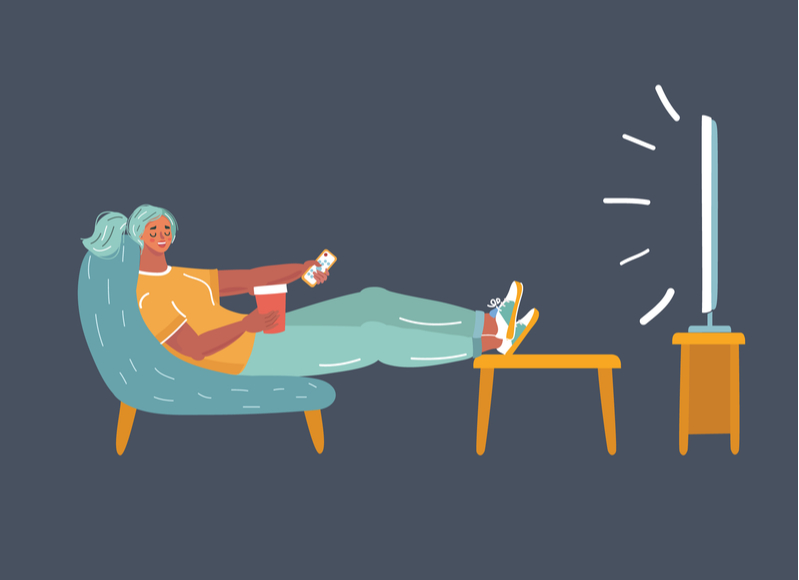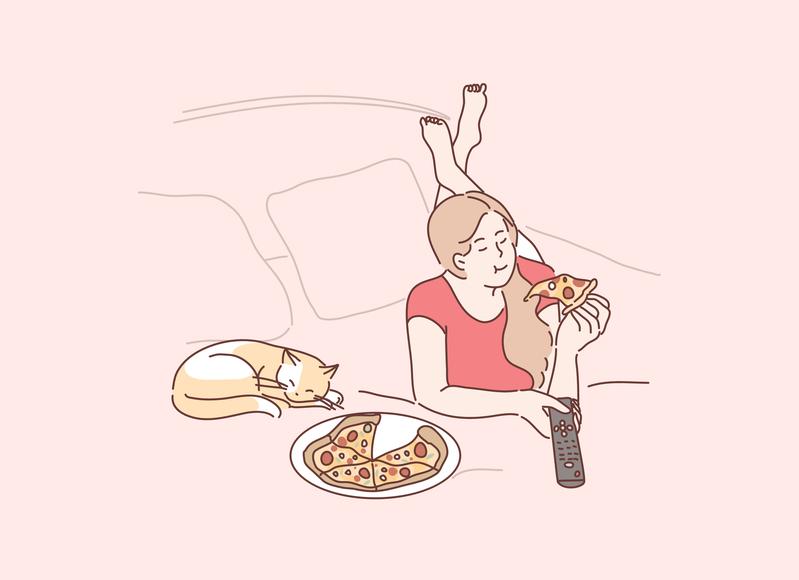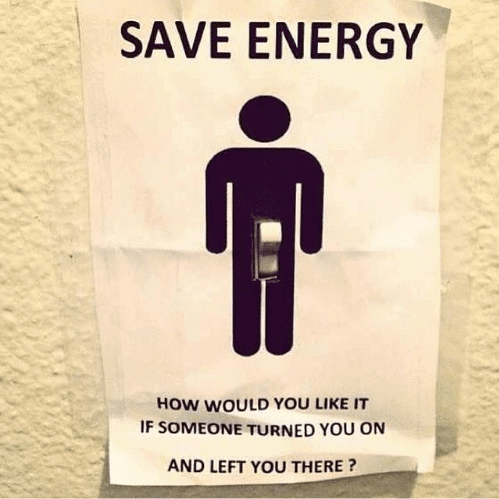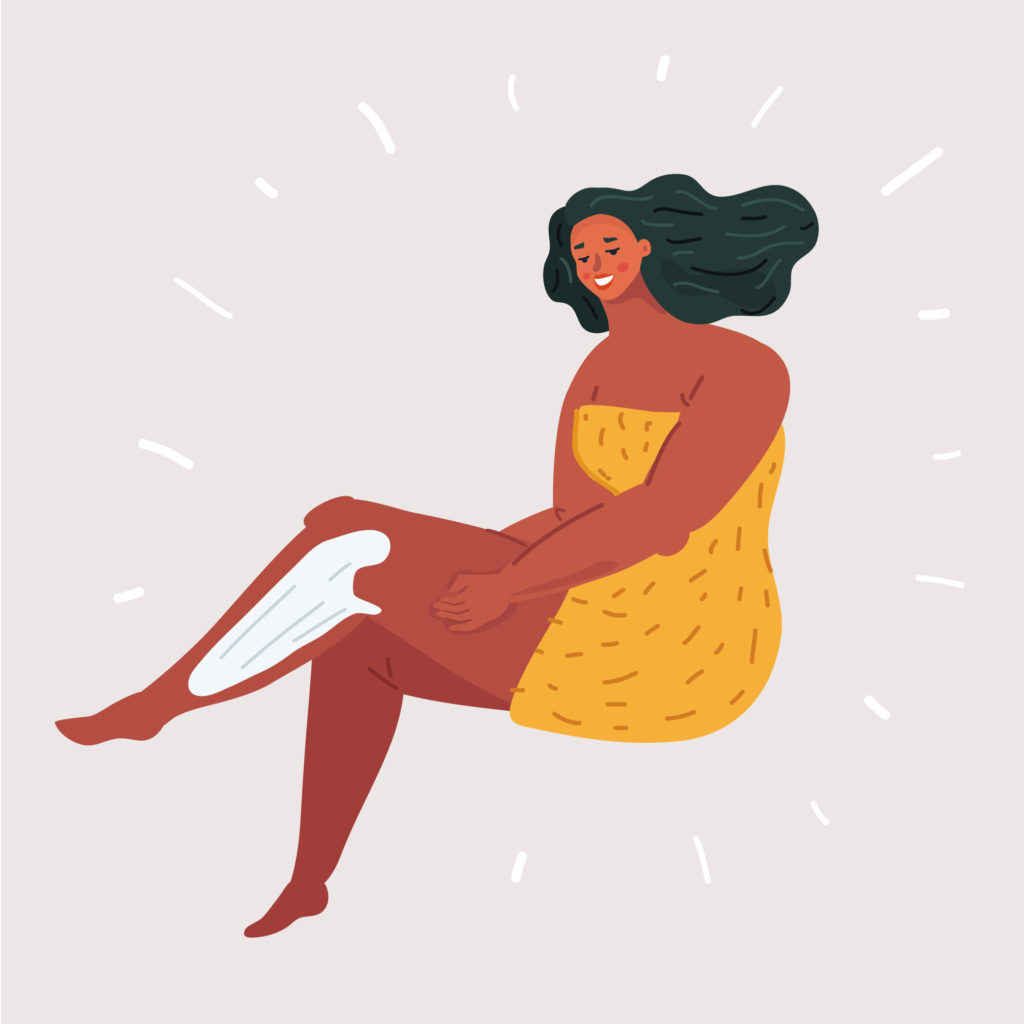We all experience our chronic illnesses differently, which means our flares are different. No matter how your body responds when it’s worn out, the most important thing is to come prepared so you can rest.
A chronic illness flare survival (or crisis) kit includes items that help alleviate the symptoms you feel when your body’s health suddenly worsens.
Here are 27 things you might need in your bedroom to help you get over your flare as smoothly as possible.
A Weighted Blanket to Improve Your Quality of Sleep
Weighted blankets are a fan-favourite of mine (and my collection just keeps growing). These heavier blankets soothe anxiety, stress and insomnia – improving your overall quality of rest.
It’s suggested they could achieve this by calming your fight or flight response and activating your parasympathetic nervous system, which helps you rest.
I also find weighted blankets leave you feeling quite safe in vulnerable moments.
A Supportive Pillow to Alleviate Joint & Muscle Pain
Even a good pregnancy pillow is a great idea!
This is especially important if you have chronic pain, and it even hurts to lie down. Without the right support, you might find yourself tossing and turning quite a bit from discomfort.
When I flare, I tend to lie on my side and keep one between my legs, one behind my back, one by my stomach, one under my arm and, of course, one under my head.Thermal Socks & Slippers to Alleviate Chronic Pain From the Cold
If you have chronic pain or circulatory issues, you might find it helps to use compression socks. However, if you suffer from the cold, as I do, then something thermal is always a winner.
If you’re comfortable wearing wool or a vegan alternative – it will last a long time and never let you down.
When it comes to choosing a pair of slippers – it depends on what is comfortable for you. I find that using any podiatrist-approved shoes are a far better investment.
My three favourite brands for comfortable home-wear include Birkenstocks, Uggs and Timberlands.
Comfortable Loungewear You Can Alternate as Pyjamas
Initially, I had frumpy old pyjamas that kept me comfortable and don’t get me wrong – they did the job. But they also made me feel a little demotivated every time I looked in the mirror.
Loungewear that can double-up as pyjamas is the best way to go _ especially because it's easy to pair with a jersey and some sneakers to look semi-presentable when your takeout arrives.
If you’re interested in learning more about how to dress dynamically and comfortably when you have a chronic illness, I give lots of examples and new ideas in this article: 16 Fool-Proof Fashion Hacks for Chronic Illness
A Fan & Heater to Regulate Your Body Temperature
Regulated room temperature is so important – especially if temperature dysregulation is a symptom of your chronic illness. Without it, you'll find it difficult to settle down and rest.
The standard recommendation is to keep your room temperature between 16℃ – 18℃ and wear socks or keep a hot water bottle by your feet.
The goal is to keep the room slightly cooler than you. Then use your socks to re-adjust your internal thermostat to distribute heat throughout your body. This tells your brain that you’re ready to rest.
Netflix Subscription to Keep You Distracted From Your Flare

A big part of coping when you flare is keeping distracted and entertained. Thanks to technology – we can make this happen.
Something like Netflix will help time go by much faster. Just remember to:
- Write down everything that’s suggested to you.
Every time you are recommended a movie or series, take a note of it on your phone. That way, when you’re not feeling well, you can just scroll through your personalised movie playlist and just pick one. - Think about your stress and anxiety.
What you choose to watch can have quite an impact on your levels of stress – whether you feel it consciously or not. So as much as Netflix makes murder mystery documentaries enticing – avoid them if they heighten your anxiety.
A Multifunctional Laptop Table To Reduce Back and Neck Pain
It doesn’t need anything fancy, just something that you can use from your sofa or bed.
By keeping your device upright and aligned to your face – you don’t strain your neck and cause more pain than is necessary. Additionally, you can use it to hold your tablet, phone or even books in position.
This little stand will change tech-use habits for the best. Especially since it helps keep your laptop cool (unlike what happens when you keep it on your lap).Headphones to Help You Zone Out and Rest
Headphones are such a handy accessory to have, especially if you can opt for noise-cancelling ones. Sometimes when you flare, you need to zone out a little to rest and stop background noise from causing unnecessary added tension.
I particularly like to use these when I’m listening to my meditation or relaxation tracks. It helps me calm my mind and slow my breath down, so it’s easier to fall asleep.
Music Playlists To Reduce Stress and Physical Pain
Music is an incredible distraction and healer – and it’s proven. Here are some of the ways it can help you while your chronic illness is flaring:
- It helps your body recover from stress better.
- It helps you get better sleep.
- It lifts your mood and can help with depression.
If you want some playlist inspiration. Here are some that help me out: 20 Songs That Must Be on Your Chronic Pain Music Playlist
An Extended Charger & Multi adaptor To Make Working From Bed More Convenient
If your flares are anything like mine – they’re long! And having to wait for your devices to charge, especially halfway across the room, is not practical.
Nor is having them charge right by your side, but attached to a short capable that makes it impossible to hold over the bed.
Invest in longer charging cables, extension cords and multi adaptors so that everything can run smoothly without having to rummage or fuss.
Puzzle and Colouring Books to Help You Feel Productive
A much as I love reading novels, if I’m not in the best headspace and in a lot of pain – I just can’t do it.
Brain fog definitely plays a role in this as I find myself rereading pages three times as I instantly forget what I’ve read the minute I finish.
Puzzle and colouring books don’t need to be hard – just fun. If you want one that’s meant for kids, then that’s fine.
A Journal to Document Your Chronic Illness

If you don’t want to read a book, why not write one? Sometimes it’s good to get all your thoughts and daily issues out on paper, especially when you’re not feeling well.
Journaling will help alleviate some stress and anxiety as you pour your emotions into written words. Not to mention it will also help strengthen your memory – writing stuff down is a simple way to tell your brain you need to remember it!
Step-by-Step Books When You Have Minimal Focus
Sometimes it’s the overwhelming amount of text-heavy pages that can throw you off reading. But not all books are made and written in the same way.
Lifestyle books (health, fitness, food or travel) are often a lot less intense to read and quite visually stimulating.
One of my favourite books to read when I’m flaring and need a fun way to reshift my focus is The Subtle Art of Not Giving a Fuck by Mark Manson.
DIY Crafts to Take Your Mind Off the Pain
Being low-key productive can be very encouraging during periods where you’re bedridden.
One way that I’ve always loved keeping busy is through basic crafting. I avoid anything very messy that requires glue, glitter or paint because it’s hazardous on the bed. Not to mention you’ll have to get out of bed quite a bit to clean up the crazy mess these things make.
I recommend sticking to crafts with easy-to-carry equipment, which doesn’t pose any extra-cleaning risks for you.
Knitting or crocheting
If you’re new to this and want to try it out – now is the perfect time. YouTube and Pinterest are filled with incredible tutorials and ideas.
You can start by making yourself some comfortable sweaters, socks and blankets. You can always turn it into a small business or use the hobby to make gifts for your loved ones if you get good.
Some of my favourite people to follow include:
Beading and jewellery-making

Here is a picture of me in my wheelchair, hosting a jewellery sales morning in 2011.
This is a favourite hobby of mine. When I was bedridden, it helped me release my creativity and was so rewarding; I even started my own small side business with it.
I loved this because it gave me purpose, and it helped me give back to the community. I donated a portion of the money I earned to a charity supporting research in CRPS.
Sketching or drawing
All you need is a pen and some paper for this. I also guarantee that you don’t need to be the next Picasso to have a little fun drawing.
If you’re a little shy unsure about freehand sketching – buy some tracing paper and start with outlines.
This is especially fun to try with cartoon images. Once you finish, you can always stick your little creations on some cardboard and make personalised greeting cards.
If you want to do stuff from home but don’t like these options. I have a lot more for you to look through here: 25 Ways To Deal With Chronic Illness and Boredom.
Pre-prepped Freezer Meals So You Don’t Need to Cook
No matter what – you have to eat and keep as much strength as possible. I know I’m not hungry when I’m flaring, and I’m definitely not interested in cooking. So I like to keep things simple.
Every month, I like to make a big pot of soup that I bag into individual portions and leave in the freezer. It’s my favourite go-to when I need wholesome, proper food.
For more cooking ideas, read on here: 14 Energy-Saving Cooking Tips When You’re Chronically Ill
A Slow Cooker To Take the Effort Out of Cooking
If you don’t have anything in the freezer and want to avoid takeout, I recommend getting your slow cooker out.
Curries, stews, casseroles, lasagne – your options are endless. And it takes 10 minutes to chuck everything in there and forget about it until you’re hungry.
Snacks To Help You Eat When You’re Not Hungry

Try to get individual portioned dried snacks that you can easily open, eat and discard afterwards with no mess. Things like nuts, pretzels and dried fruit all work well.
Snacks like this also make it easy for you to keep a few things in your bedroom for when you’re feeling a little peckish. And if you’re good at pacing yourself – then I recommend it.
I also like to keep some yoghurt (normal and frozen), chopped fruit and things like carrot sticks and hummus in the kitchen. Super easy snacks to enjoy and store in your fridge for a while.
Electrolyte Water to Rehydrate You Quickly
Keeping hydrated is important at any time, but especially if you’re on a lot of medication (and need to care for your kidneys or bladder).
Electrolyte water can help you rehydrate quickly if you’ve been sweating heavily or suffering from vomiting or diarrhoea.
All the Medication You Need
I’m not just talking about your prescription meds (which are obviously very important). I’m talking about all the over-the-counter items that help your body tolerate prescription drugs and ease any symptoms you have.
I have a wide variety of chronic illnesses – ranging from severe nerve pain, autoimmunity to circulatory issues. Each one needs individual attention.
So I understand that everyone is different and therefore the meds you keep next to your bed need to be different too. As a general rule, here is what I like to have handy if a flare comes:
- An immune booster;
- Electrolyte tabs;
- Cortisone cream;
- Antibiotic cream;
- Paracetamol and/or ibuprofen;
- Joint and muscle rub (such as CBD cream);
- Antiseptic cream;
- Probiotics;
- Supplements that aid digestion; and
- A blood pressure monitor.
A Loving Pet to Boost Your Mental Health
It’s 100% proven that pets can be good for your health and help aid with chronic illness. So they can help you during a flare!
The fact that you get unconditional cuddles, love and attention also helps you feel less lonely without being drained of energy.
Here are some facts about how pets can help you:
- Lower your stress, boost mental clarity and your overall energy levels.
- Help lower your pain naturally because they encourage the release of your happy hormones, endorphins.
- Keep you distracted and socially supported.
- Encourage you to move around a little as they need your care – and it feels rewarding to look after them in response.
The most important thing to remember is that pets are a huge responsibility. So remember that they need a set eating and exercise routine, and you need to be strong enough to take them out for toilet breaks.
If you’re considering a pet seriously, read this first: How Pets Can Help Chronic Pain
A Task Book to Help with Brain Fog

So even if you’re flaring – brain fog tends to get a lot worse! I recommend keeping post-it notes and a task book next to your bed to help you out.
Write everything you need to remember down and stick it on the wall next to you. It doesn’t have to look pretty – it just needs to help you.
Try to take notes in bright colours, write things down in big handwriting and make things stick out by making them comically obvious.
For example, I regularly forgot to turn off the house lights when I was in a lot of pain. So I stuck this picture up on the wall, and it helped me make a positive and instant association with switching off the lights at the end of every day.
A Chronic Illness App to Help Track Your Health
Flares are awful experiences to go through – and as much as you want them to be over quickly – you need to do your best to document them while they’re happening.
This is because your doctors need to know these insights during your next consultation. Everything you feel, from your symptoms, mood, physical changes, side effects – write it down.
Each little feeling helps your doctor understand your case a bit better. It can give them a chance to see if you have any underlying issues that need to be taken care of.
It’s also a great way to monitor your flare cycles and any progress or regression you make.
If you struggle to remember to write everything down and take photos – I recommend using a chronic illness tracker app.
This option has been such a wonderful addition to my phone as it helps me record all my medical info in one place, and it reminds me to submit a short update at the end of every day.
Baby Wipes to Make Cleaning Up Easy
There’s nothing worse than the thought of having to clean when you’re flaring. Personally, it doesn’t even hit my radar of the top 100 most important things to do when I’m in overwhelming pain.
But there’s also nothing worse than coming out of a chronic illness flare and having to do a whole bunch of cleaning. So I like to keep some hand sanitiser, baby wipes, tissues and a small bin by my bed.
That way, you can at least keep your bedroom surfaces a little clean without much effort.
If you don’t have someone to help you with housework, I recommend getting a couple of automated cleaning devices. I talk about it in detail here: 5 Ways to Make Cleaning with a Chronic Illness Easier
Epsom Salts to Soothe Tired Muscles
An Epsom soak is the perfect way to pamper yourself and REST when you’re flaring.
I always like to keep some on standby in the bathroom for when I need to unwind.
It’s recommended to use a cup or two per bath. Stay in the water for about 20 minutes before your muscles are nice and relaxed.
Given the main ingredient in Epsom salts is magnesium – it’s no wonder it helps relieve sore muscles.
Natural Body Lotion to Protect Yourself Against Infection

Looking after yourself when you’re flaring means taking care of your body’s basic needs too. Medication, in particular, is known to dry out your skin and can leave it feeling tender or susceptible to infection.
So it’s not just an aesthetics thing; it’s an aspect of comfort and wellbeing you need to consider as well.
Here are a few things I keep on standby on my bedside table or in my bathroom:
- Natural body lotion – it doesn’t matter what you choose; it just needs to be paraben & SLS free.
- Lip balm – to soothe dry or cracked lips and painful cold sores.
- Nail or cuticle oil – to keep nourished and hydrated. My nails have become extremely dry and brittle over the years from medication.
Dry Shampoo and Deodorant to Help You Feel Clean
Showering isn’t always in the cards when you’re flaring – and it’s nice to have alternatives that help you feel clean(er) and more presentable.
Keep these three things close to your bed:
- Dry shampoo and deodorant
- Antiseptic face and body wipes – another way to keep clean and fresh when you have no energy to wash up
- Hairbrush – ideally a small one that fits in your bedside table
A Visual Reminder Of How to Cope with a Chronic Illness Flare
It’s easy to act without thinking when you’re flaring – and it’s only natural. You’re tired, frustrated, and want to get back to your daily life.
Sometimes it helps to write the following things down as a visual reminder and repeat it to yourself while you’re flaring:
- Don’t fight the flare – this only makes things worse because you’re not letting your body rest, and you’re adding more mental strain on top of it.
- It’s okay to ask for help – you can’t do everything by yourself during these moments. You need to sacrifice some independence so your body can heal.
- This flare is not your fault, don’t blame yourself – I don’t care if your actions brought the flare on! Wanting to push your limits shows you’re a survivor, and that’s a good thing. Blaming yourself won’t help anyone.
- Postpone non-essential activities – this is not a time to feel guilty. If you can’t do something – you can’t do it! Your main priority is feeling better. Everything else comes second.
- Lower your environmental stress – many spoonies will agree that the main causes of chronic illness flares are overdoing it and too much stress. Now is the time to do non-stressful activities like long baths, reading, or cuddling in bed.
FREE Chronic Illness Flare Poster & Shopping List
And there we have it – the extended flare-survival kit that has taken me over 12 years to compile and perfect.
I hope you find the suggestions I’ve provided useful and manage to use them the next time you feel a flare coming.
Until then, take care of yourself and remember to rest and BE KIND TO YOURSELF.